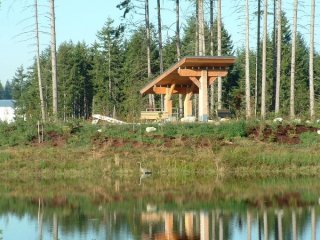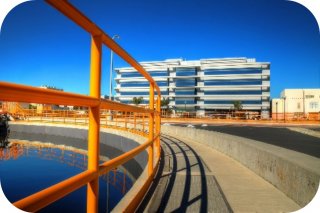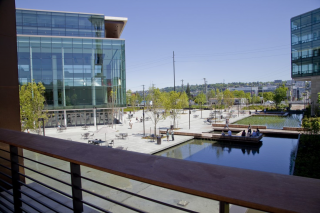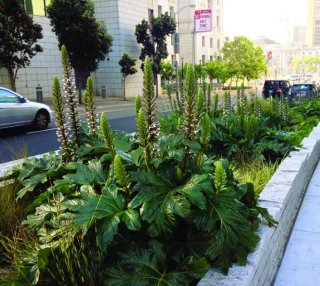Curated Topical Reuse Resources
EPA's Water Reuse team periodically collects and organizes resources related to specific topics within the domain of water reuse. This page serves as a repository for that content. As the team continues to build out these collections, this page will be expanded with those additional topics. To receive regular email updates about water reuse activities, including future additions to this page, please reach out to [email protected].
On this page:
Aquifer Storage and Recovery

Aquifer storage and recovery (ASR) is a subsurface storage practice that helps to increase resilience by protecting water supplies from evaporation, extreme weather events, and pollutants. The following WRAP actions and outputs are designed to increase the accessibility of ASR practices.
- Water Recycling for Climate Resilience Through Enhanced Aquifer Recharge (EAR) and ASR. EPA created this report summarizing different technical and policy considerations influencing how recycled water can be used to recharge groundwater (Action 7.4).
- EPA sought research applications to develop cost-benefit tools to support EAR as a viable, safe, and cost-effective water management strategy. Nearly $2 million was awarded to UC Berkeley in fall 2022 to develop a cost-benefit tool to support EAR (Action 7.7).
- The Ground Water Protection Council’s (GWPC) Aquifer Storage and Recovery-Managed Aquifer Recharge (ASR-MAR) Workgroup hosted a series of webinars to increase the understanding of current ASR practices (Action 7.4).
- ASR & Aquifer Recharge Wells in Florida
- Managed Aquifer Recharge in California: Long-Term Projects & New Emphasis Under New Groundwater Law
- What’s new with EPA? Reuse, Underground Injection Control, Stormwater
- Tools for Planning, Development, and Improvement of ASR Projects: Siting and Recovery Efficiency Assessments
- Understanding and Minimizing Arsenic Mobilization in ASR Projects
- Enhanced Aquifer Recharge of Stormwater in the United States: State of the Science Review. In this report, EPA and collaborators examine the factors that influence the performance of EAR using stormwater in different development and hydrogeologic settings (Action 7.4).
- Influence of Stormwater on Groundwater Quality and Aquifer Recharge. This webinar highlights ongoing EPA and EPA-supported research investigating the application and potential impacts to water quality using EAR technologies.
Climate Change
Incorporating water reuse as part of a community’s water portfolio can provide resilience against climate-induced impacts like drought, flooding, saltwater intrusion, and land subsidence from groundwater overdrafts. The following climate change-related resources are largely activities and outputs of WRAP action teams.
- Innovative Approaches to Water Resources Management in Adapting to Climate Change Webinar. This interactive webinar hosted by the U.S. State Department highlighted innovative water management solutions to build water security and climate resilience. The panel of U.S. and Latin American water experts educated key stakeholders about institutional structures, technologies, and stakeholder engagement strategies relevant to the water sector in Latin America and the Caribbean.
- Non-Potable Environmental and Economic Water Reuse (NEWR) Calculator. Thoughtfully scaling up decentralized onsite non-potable reuse in buildings can optimize efficiencies to reduce overall building energy and water consumption and lower carbon emissions. The NEWR Calculator was developed by EPA in partnership with the National Blue Ribbon Commission for Onsite Non-potable Water Reuse Systems. It is a web-based tool for screening-level assessments of source water options for urban building locations across the U.S. (Action 3.4).
- Fit-for-Purpose Water Updates and Life Cycle Comparisons of Non-Potable Water Reuse Scenarios Webinar. This webinar presented updated fit-for-purpose risk assessments and life cycle comparisons of non-potable reuse scenarios comprising different water sources collection scales and onsite end uses (Action 3.4).
- Ground Water Protection Council (GWPC) Webinar Series. Aquifer recharge is a growing practice in response to community water scarcity concerns because it is a resilient subsurface storage technology that is more protected from evaporation, extreme weather events, and pollutants than surface storage. GWPC’s Aquifer Storage and Recovery-Managed Aquifer Recharge Workgroup hosted a series of webinars to promote understanding and consideration of aquifer storage and recovery practices and system designs that are appropriate for specific community goals (Action 7.4).
- Water Reuse Technology in Federal Small Business Innovation Research (SBIR) Programs. All technologies funded by the EPA SBIR program use a lifecycle approach to account for energy use and carbon emissions that affect climate change. Nine small businesses were awarded EPA SBIR funding of up to $100,000 to develop and commercialize novel water reuse monitoring and treatment technologies. The solicitation for 2022 emphasized decentralized non-potable technologies that could support smaller communities where more expensive, centralized reuse systems may not be a good fit (Action 7.5).
Drought
Water reuse provides a reliable, local source of water that can augment groundwater supplies and mitigate the impacts of drought on a community. The following drought-related resources are largely activities and outputs of WRAP action teams.

- Israel Water Reuse Virtual Tour. These three sessions on Israel’s approach to policy and regulation, implementation and technology, and agricultural irrigation efficiency through water reuse demonstrate Israel’s global leadership in addressing chronic water scarcity (Action 11.1).
- Water Reuse: An Essential Tool in Addressing Global Water Scarcity Webinar. This interactive webinar hosted by the State Department included a panel of reuse experts who described best practices, technologies, and policies that can reduce water scarcity and raise public awareness for water reuse, emphasizing the South and Central Asia region (Action 11.2).
- USDA’s Environmental Quality Incentives Program WaterSMART Initiative Priority Areas. USDA’s Natural Resources Conservation Service selected 31 WaterSMART initiative priority areas for funding to modernize infrastructure and build drought resilience, including the Tulare Irrigation District that delivers treated wastewater to groundwater recharge facilitates for reuse on 230 farms (Action 2.12).
- Integrating Water Reuse into the Clean Water State Revolving Fund (CWSRF). Understanding the drivers and benefits that lead a community to pursue water reuse is important for a CWSRF program to properly evaluate projects. The most common driver for water reuse is the threat of water scarcity from drought and the desire to reduce potable water demand (Action 6.2A).
- National Alliance for Water Innovation (NAWI) Roadmap Publication Series. NAWI’s analyses revealed that across all water sectors, users expressed concern about implications of water scarcity and drought from climate change, driving the pursuit of nontraditional water sources and water reuse (Action 4.6).
- Global Water Intelligence Desalination and Reuse Roundtable Webinar. As water scarcity decreases the reliability of existing water sources, this webinar provides insights into the increasing attractiveness of water reuse and desalination projects and business opportunities, drivers, and policies that shape the market.
- Engagement with the National Drought Resilience Partnership (NDRP). Regular coordination with the federal NDRP fosters advocacy for water reuse as an effective means to build long term drought resilience (Action 2.7).
Stormwater
Are you interested in learning more about stormwater capture and use? Check out related resources produced by WRAP action teams over the last year.

- Stormwater Capture and Use Infographics. EPA recently released two infographics, one for onsite reuse and another for community-scale reuse of stormwater in the urban environment (Action 3.3).
- New action! The Pacific Institute is leading the development of a report to establish the baseline understanding of the untapped volumetric potential for urban SCU to help resolve the existing water supply demand gap in Colorado and identify and monetize the co-benefits of SCU (Action 5.8).
- This stormwater capture and use webinar series is hosted by NMSA, ReNUWIt, WEF, JFW, EPA, and WateReuse (Action 3.3):
- Stormwater Capture Drivers, Impediments, and Future Visions
- Treatment Standards for Stormwater Capture and Use: How Are We Doing?
- Achieving Multiple Benefits Through Stormwater Capture and Use Projects
- Enhanced Aquifer Recharge: Influence of Stormwater on Groundwater Quality and Aquifer Recharge. EPA ORD hosted a webinar that highlights the state of the science on information leading to best practices for enhanced aquifer recharge using stormwater (Action 7.4).
- Keys to Success: Water Recycling in Tribal Communities. The San Pasqual Band of Mission Indians and EPA presented this webinar, which includes examples of stormwater reuse (Action 2.15).
- 2020 State Summit on Water Reuse Meeting Notes Summary. This document summarizes a session on stormwater and aquifer recharge approaches to maximize co-benefits and was completed by ACWA, ASDWA, ASTHO, ECOS, and GWPC in collaboration with EPA and WateReuse (Action 2.2).
Onsite Non-Potable

Onsite non-potable reuse is the use of treated onsite collected waters for non-potable purposes at the single-building or district scale that helps reduce potable water demand and reduces pressures on centralized and stormwater treatment systems. The following WRAP actions and outputs are designed to increase understanding and the accessibility of onsite non-potable reuse practices.
- Onsite Water Reuse Case Studies. This page describes the ways that water reuse is used to benefit communities across the United States and highlights example projects that describe how a particular benefit drove the adoption of water reuse. For example, the revitalization of the Domino Factory project in Brooklyn, New York includes a non-potable water reuse system which will collect and treat wastewater from five newly constructed buildings and reuse it for toilet flushing, cooling tower make-up and irrigation. Additionally, Corkscrew Swamp Sanctuary in Florida contains a “Living Machine®” system that treats wastewater generated onsite from the facility restrooms and recycles it for toilet flushing. (Action 11.3)
- Closing America’s Wastewater Access Gap Community Initiative. EPA and USDA-Rural Development launched a decentralized wastewater initiative to the estimated 2.2 million people in the U.S. who lack basic running water and indoor plumbing in their homes using technical assistance funding from the BIL. The initiative will be piloted in 11 places across the southern regions of the country that have demonstrated significant need (Action 8.5).
- Developing Research and Tools to Support Onsite Non-Potable Water Reuse Systems (ONWS). This action, led by the National Blue Ribbon Commission for ONWS in collaboration with six partner organizations, supports the implementation of ONWS that are protective of public health and develops research to refine and expand risk-based water quality standards for use in ONWS. The following resources were developed under the scope and partnerships from this action (Action 3.4).
- Onsite Water Recycling: An Innovative Approach to Solving an Old Problem. The San Francisco Public Utilities Commission (SFPUC) published this e-book to help inspire utilities and government leaders to consider implementing onsite non-potable water treatment systems as an effective strategy for long-term water resource and resilience planning. The e-book includes stories, projects, and lessons learned.
- Onsite Water Reuse in San Francisco Webinar Series. The San Francisco Public Utilities Commission and the San Francisco Department of Public Health hosted a series of water reuse webinars that provided key updates and technical guidance on implementing onsite non-potable water reuse systems in San Francisco, California. The webinar series, available under the “More Resources” tab, includes one session on onsite water reuse program updates, two sessions on decoding log reduction targets and pathogen crediting, and one session on lessons learned from successful onsite reuse systems.
- Onsite Non-potable Reuse for Large Buildings: Environmental and Economic Suitability as a Function of Building Characteristics and Location Research Report. In this study, researchers evaluated four non-potable reuse system types—rainwater harvesting, air-conditioning condensate harvesting, and source-separated graywater and mixed wastewater membrane bioreactors—in terms of their ability to satisfy onsite non-potable demand, their environmental impacts, and their economic cost.
- Fit-for-Purpose Water Updates and Life Cycle Comparisons of Non-Potable Water Reuse Scenarios Webinar. This webinar presented updated fit-for-purpose risk assessments and life cycle comparisons of non-potable reuse scenarios comprising different water sources collection scales and onsite end uses. Presenters also shared the Non-potable Environmental and Economic Water Reuse Calculator (NEWR), an explicit web-based tool for zip code-based available water quantity estimation and life cycle evaluation of reuse configuration options.
- Human- and Infrastructure-Associated Bacteria in Greywater. In this publication, researchers review what is known about bacterial communities in different types of greywater and its infrastructure using metagenomic sequencing.
- Developing an NSF Protocol for Deployable Greywater Reuse Systems. The U.S. Army Public Health Center is collaborating with NSF International and the Department of Defense Joint Medical Services to develop a protocol to evaluate the performance of deployable and decentralized non-potable greywater reuse treatment systems not intended for permanent installations. A protocol does not currently exist to quickly validate the performance of onsite systems to support their strategic deployment in field and other temporary operations (Action 4.8).
- Incorporating Onsite Reuse Research into Codes and Standards for Premise Plumbing. Building on work under Action 3.4, including research on risk-based ONWS treatment targets, this action incorporates water quality research on onsite water treatment, storage, and delivery into building plumbing codes and standards at the national level, which can be adopted by local jurisdictions (Action 2.18).
- Compiling Existing Fit-For-Purpose Specifications. The Regulations and End-Use Specifications Explorer (REUSExplorer) includes available state onsite regulations. It is searchable by state, source of water (e.g., onsite collected water) and reuse application (e.g., onsite non-potable reuse) (Action 3.1).
